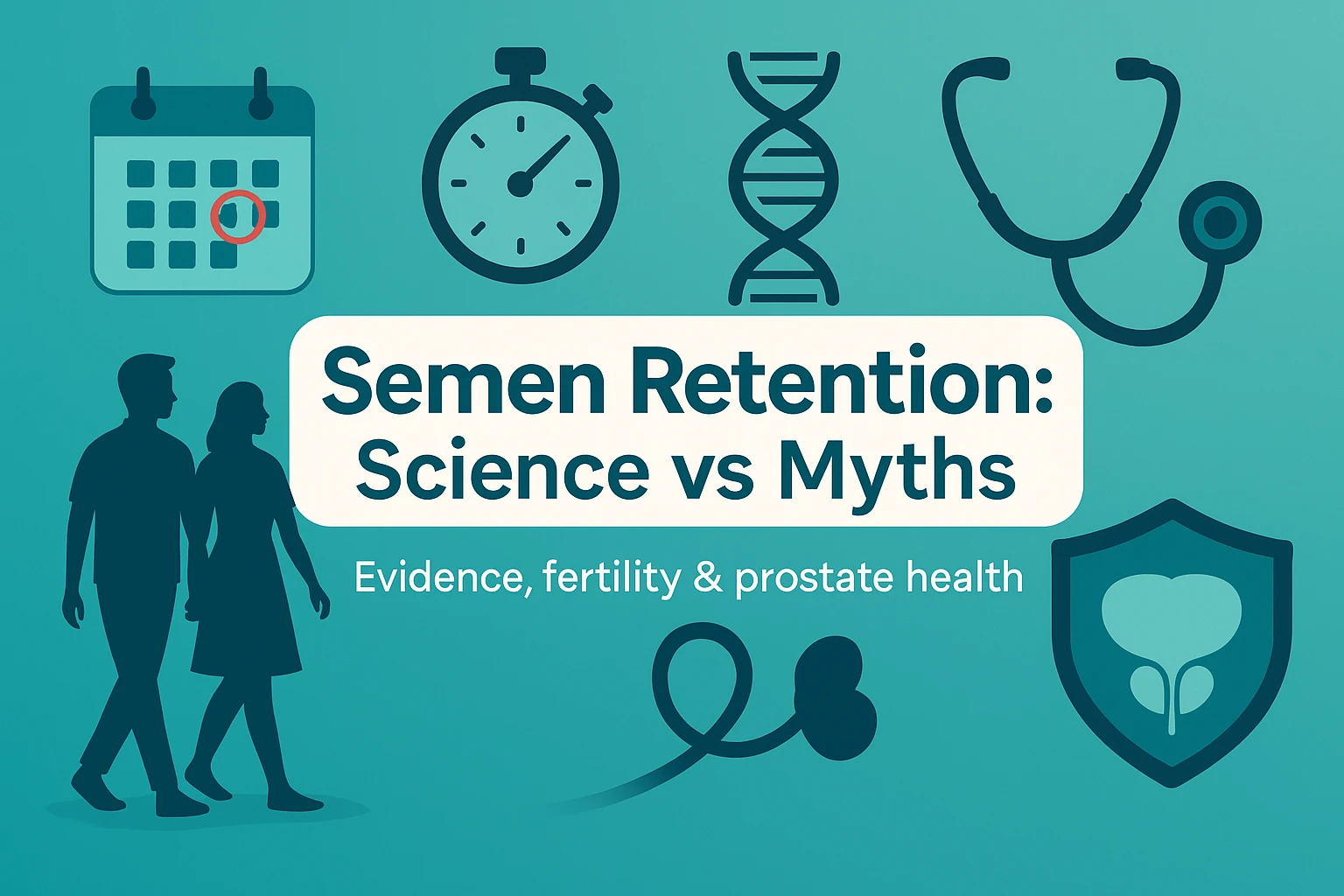“Semen retention” usually means deliberately avoiding ejaculation for days or weeks, often with the hope of boosting energy, focus, testosterone, athletic performance, or even fertility. It’s a popular topic online, but what does medical research actually say?
Short answer: There are some contexts where spacing ejaculations matters (for semen testing or certain fertility scenarios), and there’s emerging evidence that very frequent ejaculation can support prostate health. But many headline claims about huge hormonal surges or guaranteed performance gains don’t hold up under scrutiny. Let’s unpack the evidence in plain language.
What exactly is semen retention?
Semen retention refers to intentional periods without ejaculation—through abstinence, avoiding masturbation, or stopping intercourse before climax. Historically, it’s tied to cultural or spiritual practices. In health discussions, it’s often promoted as a way to “conserve” vital energy or raise testosterone.
From a medical lens, ejaculation frequency chiefly influences:
- Semen test results (because the last abstinence interval changes volume, count, motility, and DNA quality of sperm).
- Prostate health risk markers over decades.
- The chance of pregnancy for couples trying to conceive (because timing and frequency around ovulation matter).
Large, lasting boosts to testosterone, memory, or athletic output from “retaining” semen are not well supported by robust studies.
Quick myth-check (claims vs. science)
| “Retention raises testosterone dramatically.” | The often-cited small study claiming a ~45% testosterone spike on day 7 was retracted; overall, consistent long-term rises from abstinence aren’t supported. PubMed |
| “Ejaculating less makes sperm stronger.” | Shorter abstinence intervals often show better motility and lower sperm DNA fragmentation, while longer abstinence raises volume and count but may worsen DNA quality. PubMedPMC |
| “Retention boosts fertility chances.” | For natural conception, major guidelines advise regular sex—every 1–2 days during the fertile window (or every 2–3 days through the cycle). Prolonged abstinence can reduce monthly chances simply by missing fertile days. ACOG+1NICE |
| “Frequent ejaculation harms the prostate.” | Long-term data suggests the opposite: higher ejaculation frequency is linked to a lower risk of prostate cancer later in life. PMCPubMed |
Semen quality 101: how abstinence changes the numbers
When andrologists test semen, the abstinence window matters. The WHO laboratory manual (6th edition) standardises semen collection after 2–7 days of abstinence to make results comparable between labs. PMC
What happens biologically when you change the gap between ejaculations?
- Longer gaps (e.g., 5–7 days): typically more volume and higher sperm concentration, so the total sperm per ejaculate can be higher. But motility may be similar or slightly worse, and DNA fragmentation can creep up. EcermPubMedPMC
- Shorter gaps (e.g., 24–48 hours, even same-day “second sample”): typically less volume and concentration, but better progressive motility and lower DNA fragmentation—qualities that can matter in assisted reproduction or when DNA damage is a concern. PMC+2PMC+2SpringerOpen
A recent systematic review (2024) concluded that short abstinence is associated with better sperm motility and lower DNA fragmentation, while longer abstinence raises concentration. That means there’s no single “best” interval; it depends on the goal. PubMed
Takeaway: If you’re testing semen, follow the lab’s abstinence instruction (often 2–7 days). If you’re working with a fertility specialist on sperm DNA issues, they may suggest shorter intervals or a second ejaculate strategy for lab use. Don’t change your plan without discussing it with your clinician.
Does semen retention raise testosterone?
This is where hype outpaces evidence. The most-shared study suggesting a marked testosterone surge on day 7 was retracted and hasn’t been convincingly replicated. PubMed
What we do know:
- Acute after-orgasm changes in hormones like prolactin and oxytocin occur, but they’re short-lived and don’t prove long-term testosterone suppression or enhancement. PMC+1
- Day-to-day testosterone varies with sleep, stress, weight, alcohol, illness, and medications far more than with ejaculation timing alone.
Bottom line: There’s no high-quality evidence that semen retention sustainably raises testosterone or muscle-building capacity.
Prostate health: what long-term studies suggest
Large cohort studies following men for decades found that higher ejaculation frequency in adulthood was associated with a lower subsequent risk of prostate cancer. In one analysis, men with 21+ ejaculations per month had a lower risk compared with those at 4–7 per month. Mechanisms may include clearing prostatic secretions and reducing inflammatory exposures, but causation isn’t proven. PMCPubMed
This doesn’t mean more is automatically better for everyone; it does mean there’s no evidence that sexually active men are “wearing out” their prostate by ejaculating regularly.
Trying for a baby? Frequency matters more than retention
For natural conception, the most important factor is timed, regular intercourse so sperm are present when the egg is released. Medical bodies recommend:
- Every 1–2 days during the fertile window (about the five days before ovulation and the day of ovulation), or
- Every 2–3 days throughout the cycle if predicting ovulation is stressful. ACOG+1NICE
Prolonged retention can decrease monthly chances simply by reducing how often sperm meet egg. If male-factor issues are identified (e.g., high sperm DNA fragmentation), a clinician might individualise advice—often towards shorter abstinence around treatment days. PMC
If you’re beginning a fertility evaluation, learn what a semen test shows and how results are interpreted: see our primer on semen analysis basics and male-factor infertility.
Mental health, mood, and energy: what to expect
Many people say they feel calmer or more focused when they abstain; others feel more irritable or get nocturnal emissions if they retain for long. These experiences are valid, but they’re not strong clinical endpoints. Physiologically:
- After orgasm, there’s a brief refractory period, and hormones like prolactin rise transiently; any “sleepy” or relaxed feeling doesn’t translate into long-term hormonal suppression. PMC+1
- Nocturnal emissions (involuntary ejaculations during sleep) are normal safety valves when retention is prolonged; they’re not harmful. If they’re very frequent and distressing, speak with a clinician to rule out other issues. (Research on frequency is limited and varies by age and sexual activity.) PubMed
There’s no robust evidence that semen retention on its own improves memory, VO₂ max, or academic/work performance. Sleep quality, nutrition, physical activity, and stress management have far stronger evidence for energy and focus.
When semen retention may be reasonable—and when it isn’t
Potentially reasonable (with context):
- Preparing for a semen analysis: follow the lab’s requested 2–7-day abstinence for standardised results. PMC
- Targeted fertility plans: where a specialist recommends short abstinence (e.g., 24–48 h or a second ejaculate the same day) to optimise motility or DNA integrity for procedures. PMC+1
Not helpful (and may be counterproductive):
- Trying to conceive naturally but having sex infrequently due to retention goals—this can reduce the chance of pregnancy. ACOGNICE
- Chasing testosterone boosts—current evidence doesn’t support durable hormonal benefits. PubMed
Evidence snapshot: abstinence interval vs. typical semen findings
| 2–7 days (WHO standard for testing) | ↑ Volume, ↑ concentration | Neutral to slightly ↓ | Neutral to ↑ | Routine semen analysis to compare against reference values. PMC |
| ~24–48 hours | ↓ Volume, ↓ concentration | ↑ Progressive motility (often) | ↓ SDF (often) | When a clinician aims to improve sperm quality for lab use or IUI/IVF/ICSI. PubMedPMC |
| Same-day second ejaculate | Lower volume than first | Similar or ↑ | ↓ SDF in many studies | Collecting a second sample for assisted reproduction or in high-SDF cases. PMCSpringerOpen |
Note: Individual responses vary; your doctor may tailor abstinence timing to your semen profile and treatment plan.
Safety notes and when to seek care
Semen retention is not a medical treatment. If you notice blood in semen, painful ejaculation, testicular pain/swelling, fever, or foul-smelling discharge, seek medical care promptly—these are red-flag symptoms that need evaluation. If sex is becoming stressful or painful, or if mood concerns intensify, a clinician or counsellor can help.
Practical, evidence-based tips
- For fertility: prioritise regular, low-stress intimacy—every 1–2 days in the fertile window, or every 2–3 days across the cycle. Use ovulation tracking only if it reduces stress. ACOG+1
- For semen testing: follow the lab’s abstinence instruction (often 2–7 days), collect the entire sample, and deliver it within the specified time. PMC
- For high SDF or certain ART plans, your fertility specialist may advise shorter abstinence or a second ejaculate strategy; this is evidence-supported in selected scenarios. PMC+1
- For prostate health: don’t fear regular ejaculation—long-term data associates higher lifetime frequency with lower prostate cancer risk, though the cause isn’t fully proven. PMCPubMed
Explore related guides on IVFix: male-factor infertility, semen analysis basics, and how these intersect with IVF success rates.
Bottom line
There’s no magic in “retaining” semen for most health goals. For many people—especially those trying to conceive—regular ejaculation and well-timed sex are more beneficial than long abstinence. In certain fertility treatments, short abstinence or a second sample can fine-tune sperm quality for the lab—but that’s a clinician-guided strategy, not a DIY hack. If you’re curious about how ejaculation timing might fit into your fertility journey, talk with a reproductive specialist.
For more expert, evidence-based women’s health and fertility content, visit IVFix.in—we’re here to help you navigate the science with confidence and compassion.




